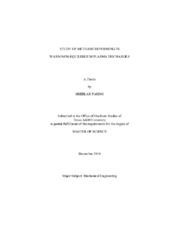| dc.contributor.advisor | Staack, David | |
| dc.creator | Parimi, Sreekar | |
| dc.date.accessioned | 2012-02-14T22:19:06Z | |
| dc.date.accessioned | 2012-02-16T16:12:55Z | |
| dc.date.available | 2012-02-14T22:19:06Z | |
| dc.date.available | 2012-02-16T16:12:55Z | |
| dc.date.created | 2010-12 | |
| dc.date.issued | 2012-02-14 | |
| dc.date.submitted | December 2010 | |
| dc.identifier.uri | https://hdl.handle.net/1969.1/ETD-TAMU-2010-12-9013 | |
| dc.description.abstract | Utilization of natural gas in remote locations necessitates on-site conversion of methane
into liquid fuels or high value products. The first step in forming high value products is
the production of ethylene and acetylene. Non-thermal plasmas, due to their unique nonequilibrium
characteristics, offer advantages over traditional methods of methane
reforming.
Different kinds of non-thermal plasmas are being investigated for methane reforming.
Parameters of these processes like flow rate, discharge size, temperature and other
variables determine efficiency of conversion. An efficient process is identified by a high
yield and low specific energy of production for the desired product. A study of previous
work reveals that higher energy density systems are more efficient for methane
conversion to higher hydrocarbons as compared to low energy density systems. Some of
the best results were found to be in the regime of warm discharges. Thermal equilibrium
studies indicate that higher yields of ethylene are possible with an optimal control of
reaction kinetics and fast quenching. With this idea, two different glow discharge reactor
systems are designed and constructed for investigation of methane reforming. A counter flow micro plasma discharge system was used to investigate the trends of methane
reforming products and the control parameters were optimized to get best possible
ethylene yields while minimizing its specific energy. Later a magnetic glow discharge
system is used and better results are obtained. Energy costs lower than thermal
equilibrium calculations were achieved with magnetic glow discharge systems for both
ethylene and acetylene. Yields are obtained from measurements of product
concentrations using gas chromatography and power measurements are done using
oscilloscope. Energy balance and mass balances are performed for product measurement
accuracy and carbon deposition calculations. Carbon deposition is minimized through
control of the temperature and residence time conditions in magnetic glow discharges.
Ethylene production is observed to have lower specific energies at higher powers and
lower flow rates in both reactors. An ethylene selectivity of 40 percent is achieved at an
energy cost of 458MJ/Kg and an input energy cost of 5 MJ/Kg of methane. | en |
| dc.format.mimetype | application/pdf | |
| dc.language.iso | en_US | |
| dc.subject | Acetylene | en |
| dc.subject | ethylene | en |
| dc.subject | low product specific energy | en |
| dc.subject | Methane reforming | en |
| dc.subject | Magnetic glow | en |
| dc.subject | Micro plasma, warm plasma | en |
| dc.subject | Non-equilibrium discharge | en |
| dc.title | Study of Methane Reforming in Warm Non-Equilibrium Plasma Discharges | en |
| dc.type | Thesis | en |
| thesis.degree.department | Mechanical Engineering | en |
| thesis.degree.discipline | Mechanical Engineering | en |
| thesis.degree.grantor | Texas A&M University | en |
| thesis.degree.name | Master of Science | en |
| thesis.degree.level | Masters | en |
| dc.contributor.committeeMember | Kalyan, Annamalai | |
| dc.contributor.committeeMember | Mehrdad, Ehsani | |
| dc.type.genre | thesis | en |
| dc.type.material | text | en |


